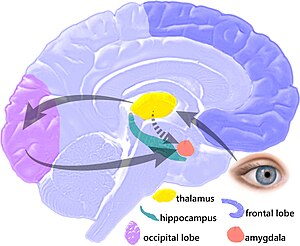
An amygdala hijack is an emotional response that is immediate, overwhelming, and out of measure with the actual stimulus because it has triggered a much more significant emotional threat.[1] The term, coined by Daniel Goleman in his 1996 book Emotional Intelligence: Why It Can Matter More Than IQ,[2] is used by affective neuroscientists and is considered a formal academic term. The amygdala is made up of two small, round structures located closer to the forehead than (anterior to) the hippocampi, near the temporal lobes. The amygdalae are involved in detecting and learning which parts of our surroundings are important and have emotional significance. They are critical for the production of emotion. They are known to be very important for negative emotions, especially fear.[3] Amygdala activation often happens when we see a potential threat. The amygdala uses our past, related memories to help us make decisions about what is currently happening.[4]
- ^ "Conflict and Your Brain aka The Amygdala Hijacking" (PDF). Retrieved 2010-04-06.
- ^ Nadler, Relly. "What Was I Thinking? Handling the Hijack" (PDF). Retrieved 2019-04-15.
- ^ LeDoux, Joseph E. (1995). "Emotion: Clues from the Brain". Annual Review of Psychology. 46 (1): 209–235. doi:10.1146/annurev.ps.46.020195.001233. ISSN 0066-4308. PMID 7872730.
- ^ Breiter, Hans C; Etcoff, Nancy L; Whalen, Paul J; Kennedy, William A; Rauch, Scott L; Buckner, Randy L; Strauss, Monica M; Hyman, Steven E; Rosen, Bruce R (1996). "Response and Habituation of the Human Amygdala during Visual Processing of Facial Expression". Neuron. 17 (5): 875–887. doi:10.1016/S0896-6273(00)80219-6. PMID 8938120. S2CID 17284478.